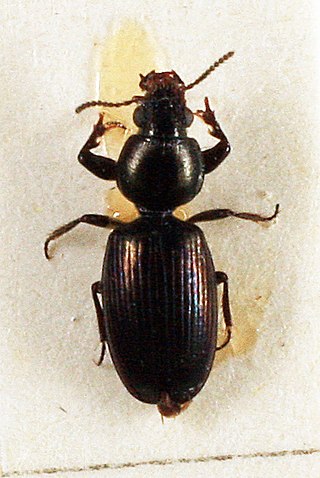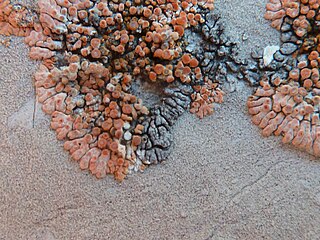
Rafflesia is a genus of parasitic flowering plants in the family Rafflesiaceae. The species have enormous flowers, the buds rising from the ground or directly from the lower stems of their host plants; one species has the largest flower in the world. Plants of the World Online lists up to 41 species from this genus, all of them are found throughout Southeast Asia.

Rafflesia arnoldii, the corpse flower or giant padma, is a species of flowering plant in the parasitic genus Rafflesia. It is noted for producing the largest individual flower on Earth. It has a strong and unpleasant odor of decaying flesh. It is native to the rainforests of Sumatra and Borneo. Although there are some plants with larger flowering organs like the titan arum and talipot palm, those are technically clusters of many flowers.

Strongylognathus is a genus of ants in the subfamily Myrmicinae. Many of its species are endemic to specific regions.

Strongylognathus arnoldii is a species of ant in the subfamily Myrmicinae. It is endemic to Russia.
Tryblis is a genus of fungi in the family Odontotremataceae. It has two species. The genus was circumscribed in 1931 by Frederic Clements, with T. arnoldii assigned as the type species; this was originally described as Blitridium arnoldii by Heinrich Rehm in 1872. Tryblis signata was added to the genus in 1997 by Martin Magnes.

Paradromius is a genus of ground beetle native to the Palearctic, the Near East and North Africa. It contains the following species:
Triplophysa arnoldii is a species of stone loach in the genus Triplophysa. It is endemic to Mongolia. It grows to 7 cm (2.8 in) SL.

Dyschirius is a genus of beetles in the family Carabidae:
Cymindis arnoldii is a species of ground beetle in the subfamily Harpalinae. It was described by Kabak in 1999.
Dyschirius nitidus is a species of ground beetle in the subfamily Scaritinae. It was described by Pierre François Marie Auguste Dejean in 1825.
Dyschirius kryzhanovskii is a species of ground beetle in the subfamily Scaritinae. It was described by Gryuntal in 1984.
Dyschirius exochus is a species of ground beetle in the subfamily Scaritinae. It was described by Whitehead in 1970.

Dyschirius obscurus is a species of ground beetle in the subfamily Scaritinae. It was described by Gyllenhaal in 1827.

Tetrastigma leucostaphylum, the Indian chestnut vine, is a flowering plant in the family Vitaceae. It is native to Sri Lanka, India, Nepal and South East Asia.
Dyschirius hiemalis is a species of ground beetle in the family Carabidae. It is found in North America.

Parmotrema arnoldii, commonly known as the powdered ruffle lichen, is a widely distributed species of lichen in the family Parmeliaceae. It has been recorded from Africa, Asia, Europe, Oceania, Macaronesia, and North and South America.
Fissidens arnoldii is a species of moss belonging to the family Fissidentaceae.
Rafflesia lawangensis is a species of parasitic plant in the genus Rafflesia. It is exclusively found in Bukit Lawang, a small tourist village in Mount Leuser National Park, North Sumatra, Indonesia. Previously misidentified as Rafflesia arnoldii, photographs taken in 2005 led to the eventual separation of Rafflesia lawangensis as a distinct species in 2010.

Calogaya arnoldii is a species of saxicolous (rock-dwelling), crustose lichen that is common and widespread in Europe and Asia. It is in the family Teloschistaceae. It was first formally described as a new species in 1876 by Hugh Algernon Weddell, as a species of Lecanora. After being transferred to Caloplaca in 1915, it was considered as a member of that genus for nearly a century. Molecular phylogenetic studies showed Caloplaca to be polyphyletic, and it was divided up into several smaller genera in 2013. Calogaya arnoldii was one of eight species transferred to the newly circumscribed Calogaya by Ulf Arup, Patrik Frödén, and Ulrik Søchting. The lichen is part of a species complex with complicated taxonomy, and in which intermediate phenotypes are frequently observed, making it difficult to reliably distinguish them. Calogaya saxicola is one such similar species, and it has often been confused with C, arnoldii in areas where they co-occur, as the differences between them are subtle.








